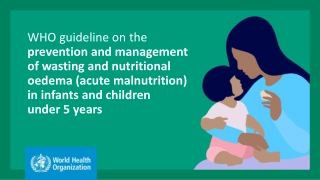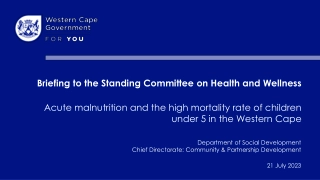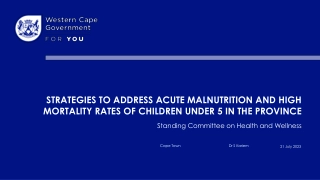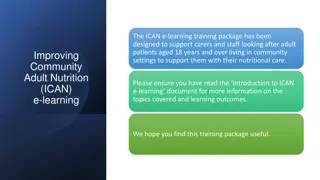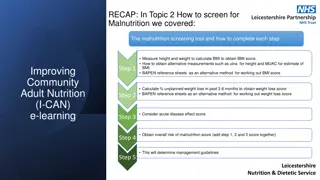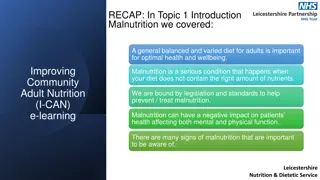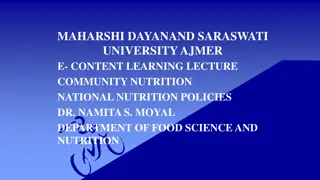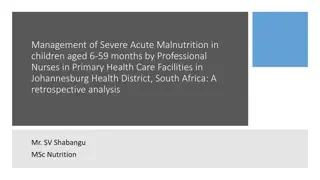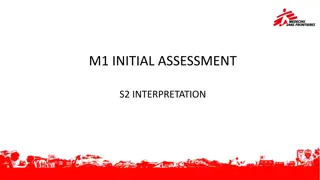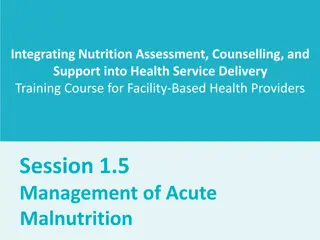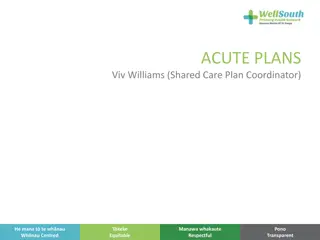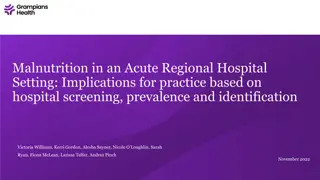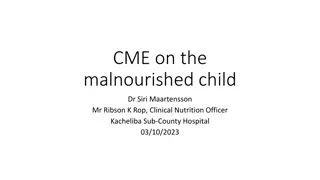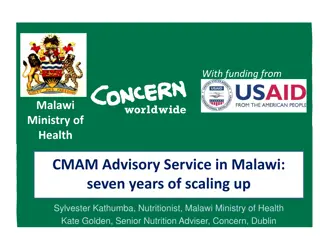Comprehensive Overview of Community-Based Management of Acute Malnutrition (CMAM)
The presentation outlines the components and continuum of care in CMAM, including screening criteria for moderate and severe acute malnutrition (MAM and SAM), community outreach strategies, outpatient care with ready-to-use therapeutic food, inpatient care for SAM cases with medical complications, services for managing MAM, and emphasis on service linkages. The 2016 CMAM guidelines updates are also highlighted, emphasizing the importance of early identification, referral systems, and follow-up care for malnourished children.
Download Presentation

Please find below an Image/Link to download the presentation.
The content on the website is provided AS IS for your information and personal use only. It may not be sold, licensed, or shared on other websites without obtaining consent from the author. Download presentation by click this link. If you encounter any issues during the download, it is possible that the publisher has removed the file from their server.
E N D
Presentation Transcript
Presentation Outline 1.Overview of CMAM: Components and the Continuum of Care 2.Updates in the 2016 CMAM guidelines
CMAM Components SCREENING Community/Health Facility WHZ> -3.0 < -2.0 MUAC 11.5 - 12.5cm PLM <22cm = Moderate Acute Malnutrition (MAM) WHZ < -3.0 WHZ <-3.0 Bilateral Pitting Oedema MUAC<11.5cm = SAM without Medical Complications Good Appetite Bilateral Pitting Oedema MUAC<11.5cm = SAM with Medical Complications or No Appetite No wasting/No Oedema = No acute Malnutrition Home SFP OTP NRU/ Inpatient Care
Components of CMAM (1) 1) Community Outreach Community assessment Community mobilisation and involvement Community outreach workers: Early identification and referral of children with SAM before the onset of serious complications Follow-up home visits for problem cases Community outreach to increase access and coverage 4
Component of CMAM (2) 2) Outpatient care for children with SAM without medical complications at decentralised health facilities and at home Initial medical and anthropometry assessment with the start of medical treatment and nutrition rehabilitation with take home ready-to-use therapeutic food (RUTF) Weekly or bi-weekly medical and anthropometry assessments monitoring treatment progress Continued nutrition rehabilitation with RUTF at home ESSENTIAL: a good referral system to inpatient care, based on Action Protocol 5
Components of CMAM (3) 3) Inpatient care for children with SAM with medical complications or no appetite Child is treated in a hospital to stabilise the medical complication Child resumes outpatient care when complications are resolved ESSENTIAL: A good referral system to outpatient care
Components of CMAM (4) 4) Services or programmes for the management of moderate acute malnutrition (MAM) Supplementary Feeding 7
CMAM Emphasis on Service Linkages IGA AGRICUTURE SUPPORT PROGRAMMES LOCAL RUTF PRODUCTION MICROFINANCE Services and programmes to prevent malnutrition In-patient care for SAM with complications CMAM Outpatient care for SAM without complications Services & programees for MAM GMP / CHD HEALTH & HYGIENE PROMOTOION MCHN U5 CLINIC COMMUNITY MOBILISATION IYCN / ENA / MATERNAL NUTRITION HTC/ PMTCT ART/ TB
Highlights of Updates in the 2016 CMAM Guidelines Low coverage and poor outcomes Limited pre-service training and orientation Service standards and guidelines Global (WHO) and national updates
Admission Criteria 2012 Protocol Includes older children >59 mo and adolescents. WHO 2013 update Older children and adolescents not included or discussed. Malawi 2016 update The inclusion of older children . 59 mo and adolescents has been retained in the revision. Includes older children and adolescents. Includes pregnant and lactating women. Did not include a section on infants < 6 mo. Include use of BMI as admission criteria. Excluded. Retained older children and adolescents. Retained pregnant and lactating women. Section on infants < 6 mo has been added to the new guidelines. BMI dropped from the criteria. Excluded. A section has been added to the 2013 WHO guidelines. Uses WHZ &MUAC.
HIV 2012 Protocol WHO 2013 update Malawi 2016 update All HIV positive children should start on ARVs irrespective of staging and CD 4 count (2016 Clinical HIV guidelines). Examine all infants less than 12months of age with confirmed HIV antibodies for PSHD. All children < 2 yrs who start ART should be referred for a new confirmatory DNA-PCR DBS sample. This can be collected on the day of starting ART. Does not mention when to start ARTs in children. All HIV-infected infants and children < 2 yrs should be initiated with ART, irrespective of clinical staging and CD4 count. All HIV-infected children > 2 yrs and <5 yrs should be started on lifelong antiretroviral drug treatment based on their CD4 count ( 750 cells/mm3) or CD4 percentage ( 25%), or if they have WHO clinical staging 3 or 4 (including severe acute malnutrition).
HIV & TB 2012 Protocol Does not guide the health worker on when to suspect TB in HIV infected children . WHO 2013 update Children living with HIV who have any one of the following symptoms poor weight gain, fever, current cough, or contact history with a TB case may have TB and should be evaluated for TB and other conditions. Children with SAM who are HIV infected and qualify for ART should be started on ART after stabilization of metabolic complications and sepsis (indicated by return of appetite and resolution of severe oedema). (Same ART regimens, and doses, as children with HIV without SAM.) Malawi 2016 update This has been added as part of the assessment for treatment failure (in conformity with the 2016 Clinical HIV guidelines). Does not mention when to start ARTs in HIV infected children. Added to guidelines in section 5.4 on in- patient treatment page 54. (In conformity with the 2016 Clinical HIV guidelines)
Micronutrient Supplementation: Vitamin A 2012 protocol Give high dose vitamin A on admission except in children with oedema page 73 (Annex 4-2 Routine Medicines for SAM in OTP/ NRU) and page 81 (Routine Daily treatment and Prophylaxis, Vitamin A) . WHO 2013 update Malawi 2016 update Give low-dose (5000 IU) vitamin A supplementation daily from the time of admission until discharge from treatment. There is no clear rationale for giving a single high-dose vitamin A supplement, unless children have eye signs of vitamin A deficiency or have had measles recently. (The vitamin A intake of children who are fed therapeutic food [F- 75, F-100, or ready-to use therapeutic foods] that complies with WHO specifications exceeds the recommended nutrient intake for well-nourished children and seems adequate for malnourished children.)
Micronutrient Supplementation: Vitamin A and Measles 2012 Protocol WHO 2013 update Malawi 2016 update The section on measles on page 82 in the current Malawi CMAM Guidelines discusses giving measles vaccines but not high dose vitamin A A high dose (50 000 IU, 100 000 IU or 200 000 IU, depending on age) of vitamin A should be given to all children with severe acute malnutrition with recent measles on day 1, with a second and a third dose on day 2 and day 15 (or at discharge from the programme), irrespective of the type of therapeutic food they are receiving. Added to the guidelines. (High-dose vitamin A supplementation reduces mortality in children with severe acute malnutrition complicated by measles- specific respiratory infections.)
Micronutrient Supplementation: Zinc 2012 Protocol WHO 2013 update Malawi 2016 update Page 97: If clinically indicated add zinc: 0-6 months: 10 mg (1/2 tablets) daily for 10-14 days and > 6months give 20 mg (1 tablet) daily for 10-14 days. Page 99: For infants < 6 months or > 6 months but <3kgn (breastfed), the current Malawi guideline is silent on the use of F-75 in edematous breastfed young infants. It only discusses the use of F100-D. If children with SAM are admitted to hospital and treated with F-75 and subsequently with ready-to- use therapeutic food, they should not receive oral zinc supplements in addition to F-75 or RUTF as these therapeutic foods contain the recommended amounts of zinc for management of diarrhea Added to the guideline. Recommendation 8.2 (bullet 3): For infants with severe acute malnutrition and oedema, infant formula or F-75 should be given as a supplement to breast milk.
Antibiotics 2012 Protocol Routine amoxicillin used in ambulatory care WHO 2013 update Routine use of ambulatory antibiotics recommended using either Cotrimoxazole or Ampicillin Antibiotics for the management of complicated malnutrition has not been discussed in the 2013 WHO updates. Malawi 2016 update Retained use of amoxicylin (CT used in HIV programme) for ambulatory care of SAM. Table 16, Page 82: Give benzyl penicillin 50,000iu/kg 6 hourly IV/IM for 48 hours then oral amoxicillin 15mg/kg 8 hourly for 5 days AND if the child fails to improve within 48 hours add Gentamycin 7.5mg/kg once a day IV/IM for 7 days or Chloramphenicol 25mg/kg IM/IV 8 hourly for 5 days Give benzyl penicillin 50,000 iu/kg 6 hourly IV/IM for 48 hours then oral amoxicillin 25 40 mg/kg 8 hourly for 5 days PLUS Gentamycin 7.5 mg/kg once a day IV/IM for 7 days. (WHO Paediatric Hospital Care 2013, page 207)
Malaria Treatment 2012 Protocol WHO 2013 update Malawi 2016 update Intravenous infusion of quinine should be used for severe malaria but with caution in severe malnutrition. (page 83) Artesunate should be used for the treatment of severe malaria. Malawi 2013 Edition of Malarial treatment Guidelines. (page 10)






